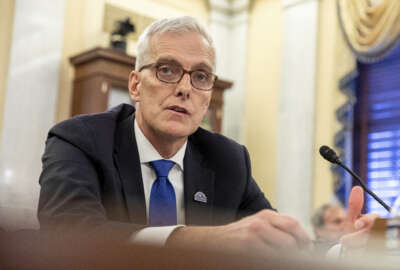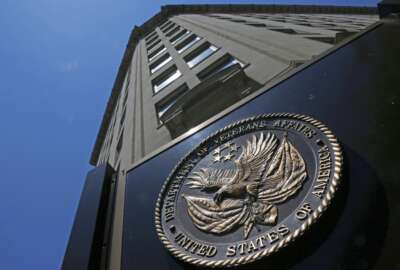

Current and former VA officials say the agenyc needs to keep streamlining the way it hires and onboards for health care workers amid a nationwide shortage.
The Department of Veterans Affairs, behind the scenes, served as an essential backstop to a civilian health care system overwhelmed at the height of the COVID-19 pandemic.
The VA provided this assistance as part of its “fourth mission” to serve the U.S. in times of war, terrorism, national emergencies and natural disasters.
As a result, it receives tens of billions of dollars in emergency funding to provide pandemic relief, as well as temporary emergency hiring and pay authorities.
While the VA is no longer able to hire and onboard health care workers in a matter of days, as it could at the start of the pandemic, current and former agency officials told the House VA Committee the VA needs to keep streamlining the way it hires and onboards for health care workers amid a nationwide shortage.
Richard Stone, the former executive in charge of the Veterans Health Administration, said the VA’s authority to rapidly hire health care workers and offer them bonuses at the height of the COVID-19 pandemic proved “absolutely essential” to bring 85,000 new employees, mostly nurses, into the agency within 10 months.
Stone said the Office of Personnel Management was an “extraordinary partner” in authorizing these emergency pay and hiring provisions. The VA under these authorities, he added, could hire personnel within three-to-five days.
Prior to the pandemic, Stone said the VA took 90 to 120 days to hire licensed medical personnel.
While the U.S. is in a much different phase of the pandemic now than for much of 2020 and 2021, Stone said the VA still needs to bring on health care workers quickly to compete with the private sector and a shortage of more than a million nurses nationwide.
“The competition for those nurses is extraordinary, and rapid hiring is necessary,” Stone said.
Without some of its emergency hiring authorities from OPM, the VHA is taking longer to complete all the steps needed to bring a new employee on board.
Undersecretary for Health Shereef Elnahal told Federal News Network in a recent interview that the current time-to-hire for VHA is around 200 days, and that improved hiring and onboarding remains his top priority.
The VHA recently completed the onboarding steps for more than 12,800 prospective employees nationwide, in an effort to keep the momentum going on streamlined hiring.
“That really was built upon the work that had been done previously, on how do you really hire rapidly and we see that as a benefit in moving forward of trying to do as many steps as we can in one day,” Deputy Undersecretary for Health Steven Lieberman said.
Fiscal 2022 was VHA’s best year for hiring on record, but the agency is still looking to pull out all the stops to meet a 52,000 hiring goal for fiscal 2023.
“This year, we are on track, we are doing much better. This is just a priority for us and we have to get this right,” Lieberman said.
Rep. Julia Brownley (D-Calif.), however, raised concerns about the VA staying on track with its hiring goals amid a nationwide shortage of medical workers and persistent burnout across the industry.
“It seems to me that our hiring within the VA, without a pandemic, without a natural disaster, it’s still sort of in emergency status, as far as I’m concerned, because it still takes so long to onboard someone,” Brownley said.
VA officials highlighted the extraordinary efforts agency employees took to respond to the pandemic.
More than 6,000 VHA employees volunteered to deploy to assist civilian or tribal health systems since March 2020.
Those employees, under the agency’s Deployable Employment Emergency Response System, responded to COVID-19 hotspots, such as New York and New Orleans, at a time when volunteers in health care were hard to find.
“Those volunteers coming from areas unaffected by an emergency were much different when the entire country was under pressure,” Stone said.
To prepare the agency for future pandemics and disasters, Stone recommended the VHA develop an additional classification of employees that spend six-to-nine months training on readiness preparation for the next major national emergency.
“I think the expansion of that workforce would allow us to deploy a mobile 20-bed [intensive care unit] to a hospital under pressure, and deliver the labor force with it,” Stone said.
The VA admitted almost 700 non-veteran patients to its facilities to help alleviate the pressure on non-VA hospitals overwhelmed by COVID-19. It also fully vaccinated more than 4.2 million veterans, with over 2.2 million veterans receiving additional vaccine doses.
The VA was able to make an additional 8,000 acute care beds available for acute care across the country it had lots of facility space available.
“We have an ancient system inside the VHA. But those big old buildings were able to accommodate expansion very quickly,” Stone said. “If we’re going to view the VHA, which I strongly recommend, as the backstop to the American healthcare system, it has to have the redundancy built into it, and the resources to do a rapid expansion.”
Committee Chairman Mark Takano (D-Calif.) said the VA with its surge efforts was “able to be the backstop for the civilian health care system, the Indian Health Service, and nursing homes throughout the country.”
“VA had to rapidly find ways to simultaneously sustain its own capacity to provide care to veterans, prevent spread of the virus among its workforce, and provide critical care to civilians — all without being able to fully estimate the scale of the danger of this new virus, or the resources the system would need to fight it,” Takano said.
Stone said VA facilities remain in serious need of modernization. The average age of its facilities is 60 years old.
Senators earlier this year blocked the formation of the Asset and Infrastructure Review Commission. But the VA expects to submit an “Infrastructure 2.0” plan to Congress in the first half of 2023.
“I think one of the toughest things you’re doing to have to tackle is how to recapitalize the system, and how to recognize that we need brick and mortar facilities where veterans are, not hours away from them” Stone said.
For all the agency’s achievements, the pandemic also exacted a heavy toll on its workforce. The agency reports 23,390 veterans and 277 VA employees died from COVID-19.
Lieberman said the pandemic exacerbated a long-term challenge of burnout and exhaustion. The VA, in response, launched its Reboot Task Force to address burnout and promote well-being among its employees.
VA officials also recommended the agency have a seat at the table for future interagency responses to major emergencies. Because of its integrated nature, VHA’s staff and supplies can move at a moment’s notice to assist in a crisis across the country.
Paul Kim, former executive director of VHA’S Office of Emergency Management, said the CARES Act allowed the VA to hire additional personnel for its logistics staff when the agency couldn’t contract with trucking and shipping companies.
“We brought that ability in-house, we bought the assets to move things. And I hired the people to do the movements,” Kim said.
Kim said he worked closely with HHS and FEMA, but said his biggest challenge was less about interagency communication than it was the speed of the federal government as a whole.
“It wasn’t an issue of the contact and access. It was just the slow movement of the bureaucracy to get things in place, contracting issues, the supply chain issues, transportation issues. Everyone was doing the best they could. But we were running into those challenges,” Kim said.
Stone also called for better interagency coordination and a “fundamental review” of the National Disaster Medical System that brought agencies together during the pandemic.
“It’s one of the reasons that I believe we cannot retreat back to our corners after this pandemic gets over with. If we do that, and fail to learn the lessons, failed to force the dialogue that can occur from this level between the agencies, shame on us, if we get to that point,” Stone said. “We must continue to force these agencies to talk to each other and to think about what the future should look like.”
The fiscal 2022 National Defense Authorization Act allowed the DoD’s assistant secretary of defense for health affairs to carry out a pilot with VA in five locations across the country to improve the interoperability and capacity of the National Disaster Medical System.
The pilot is set to begin before the end of fiscal 2023, but Lieberman told the committee he was unaware of DoD reaching out to consult on the pilot’s launch.
“We do need to look at who should lead — who’s better, by their nature better, to lead as far as the agency. I think new need some frank discussion about this,” Takano said.
Committee Ranking Member Mike Bost (R-Ill.) said the VA “started at the back of the table and had to struggle to play a prominent role in the nationwide response to the pandemic.”
Bost urged federal health care and emergency response agencies to better integrate VA into planning for future disasters.
“Government silos do not serve anyone well, especially during an emergency or disaster,” Bost said.
Copyright © 2024 Federal News Network. All rights reserved. This website is not intended for users located within the European Economic Area.
Jory Heckman is a reporter at Federal News Network covering U.S. Postal Service, IRS, big data and technology issues.
Follow @jheckmanWFED

 First Look
First Look 